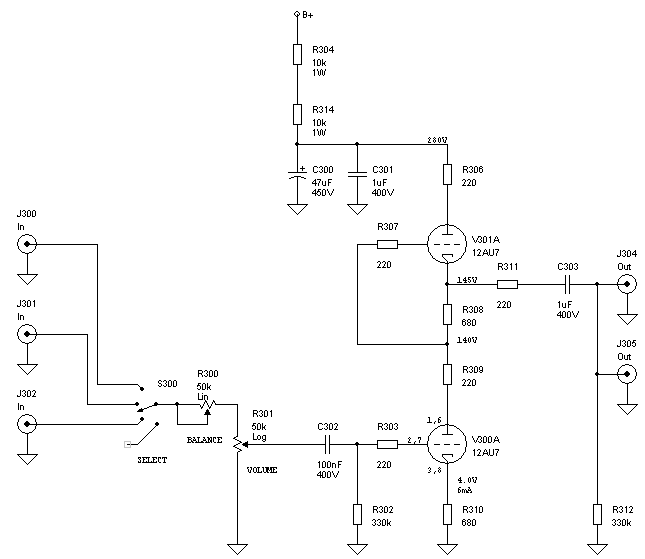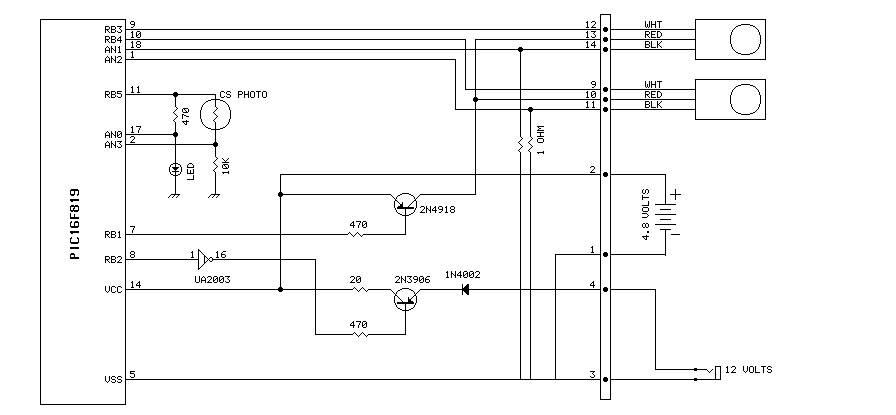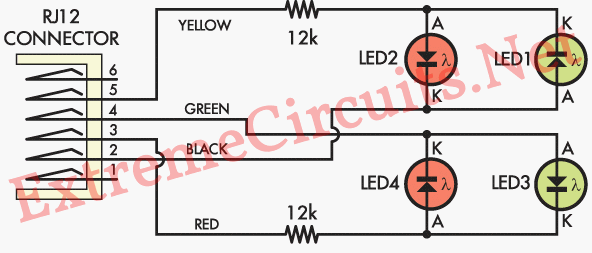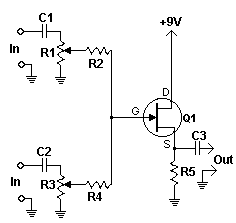
ATmega8535 Line Follower Robot
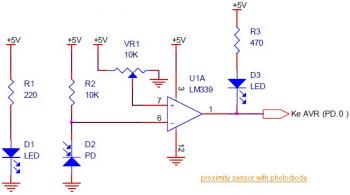
This circuit diagram illustrates a Line Follower / Line Tracker robot. The circuit is derived from tutorial documentation, which is available for download at the conclusion of this article. The line follower robot utilizes eight proximity sensor modules. Each sensor module employs photodiodes to detect the reflection of light from the line or floor. The motor driver used is the L298, which can control motors with a current output of up to 2A for a single DC motor. For dual DC motors, the output is limited to 1A per channel. This motor driver is suitable for small to medium DC motors and is ideal for applications such as line follower robots and firefighting robots. A complete line follower robot tutorial, including the schematic diagram, robot design, and source code in PDF format (Indonesian language), is available for download. The complete electrical circuit diagram of the line follower robot is based on the ATmega16 microcontroller. The circuit consists of three modules: the sensor module, the microcontroller module, and the DC motor module. An IR sensor schematic diagram and a mainboard schematic (combining the microcontroller and DC motor driver) are included. Additionally, there is a circuit diagram for a white line follower toy, where the DC motor serves as the actuator. This circuit can be employed in a toy car designed to follow a white line and is recognized as a simple robot configuration known as "line follower without microcontroller." The motor used can be a 3V type with gearing for steering. A DC motor controller circuit is also presented, built using a TIP31 transistor based on the H-Bridge concept. The switches S1 and S2 are normally open, push-to-close, press-button switches. An LED indicates the direction of motor rotation and can be any common type. The TIP31 transistors can handle up to 3A. Furthermore, there is a circuit that combines an echo chamber to create an echo effect, similar to sound reverberation in a cave, and a robot voice effect circuit that modifies audio signals to produce a robotic voice. A circuit to detect the activity of a phone line is also included, with a components list detailing resistors, capacitors, diodes, and transistors. Additionally, a motor speed controller circuit diagram utilizing the Maxim MAX4295 is provided, allowing for the control of motor speed. Resistor R1 biases the potentiometer to align with the input range of U1, where full counter-clockwise rotation of the potentiometer corresponds to maximum-speed reverse rotation of the motor.
The Line Follower / Line Tracker robot circuit is designed to autonomously follow a path defined by a contrasting line on the ground. The circuit integrates eight proximity sensors that utilize photodiodes to detect light reflections. When the sensors identify the line, they send signals to the microcontroller, which processes the input and determines the appropriate motor actions to keep the robot aligned with the path.
The L298 motor driver serves as a critical component in this configuration, providing the necessary current to drive the motors effectively. With its ability to handle up to 2A for a single motor and 1A per motor for dual configurations, it ensures that the robot can perform efficiently without overheating or exceeding its operational limits. The L298 is particularly well-suited for small to medium-sized robotic applications, offering reliable performance.
The ATmega16 microcontroller serves as the brain of the robot, receiving input from the sensor modules and controlling the motor driver accordingly. The circuit design includes a mainboard schematic that integrates both the microcontroller and the motor driver, facilitating seamless communication between the components.
For educational purposes, the schematic diagrams provided in the tutorial are invaluable for understanding the underlying principles of line following robotics. The inclusion of an H-Bridge motor control circuit using TIP31 transistors allows for bidirectional motor control, enabling the robot to navigate turns and obstacles effectively.
In addition to the basic line-following functionality, the circuit can be enhanced with additional features such as sound effects or voice modulation, achieved through the integration of echo chamber circuits and robot voice effect circuits. These features can add an interactive element to the robot, making it more engaging for users.
Overall, this comprehensive circuit design not only demonstrates the fundamental principles of line-following robotics but also serves as a foundation for further exploration and experimentation in the field of robotics and automation.This is the circuit diagram of Line Follower / Line Tracker robot. The circuit taken from the tutorial documentation. You may download the full tutorial at the end of this article. The line follower robot use 8 pieces of proximity sensor module. The sensor module use photodioda for detecting the reclection of light from the line/floor. The motor d river L298 able to control the motor with current output up to 2A for single DC motor. For double DC motors, there should be up to 1A for each output channel. This motor driver is very good for small and medium DC motor. L298 is great motor driver for small and medium size or robot such as line follower robot and fire fighter robot. Download the complete line follower robot turotial which containing od schematic diagram, robot design and source code in PDF version (Indonesian language): Tags: atmega8535 circuit, line detector circuit, line follower atmega8535 circuit, motor driver l298 circuit, photodioda circuit, proximity circuit diagram, proximity sensor circuit, Here the complete electrical circuit diagram of line follower robot which built based on ATmega16.
There are three modules of line follower robot circuit that are sensor module, microcontroller module and DC motor module. IR sensor schematic diagram: Mainboard (microcontroller + DC motor driver schematic diagram): Download the document of ATmega16 line follower robot tutorial.
This is the circuit diagram of white line follower toy. The actuator of the toy is the DC motor. This circuit can be used fora toy car to follow a whiteline, this circuit also known as very simple robot: "line follower without microcontroller". The motor is either a3v type with gearing tosteer the car or. This is a DC motor controller circuit, built using transistor TIP31 based on H-Bridge concept. The switch S1 and S2 are normally open, push to close, press button switches. The LED function is to indicate the direction of motor rotation, you may use any common LED type. The TIP31 transistors capable to handle 3A. The following circuit is the combination of echo chamber circuit that will make the sound repeated, just like an echo sound when you speak in cave.
And the robot voice effect circuit that change the audio signal from input to become sound like a robot voice. To make the robot voice effect, there are some. This circuit is used to detect whether your phone line is active or not. Components List: R1, R2, R3 = 22M Ohms R4 = 2. 2M Ohms C1 = 0. 47uF/250V Mylar caps D1 = 1N914, NTE519, or other small signal diode Q1 = 2N3904, NTE123AP Q2 = 2N3906, NTE159 Q3 = IRF510, NTE2382, MosFet This kind of circuit.
This is a motor speed controller circuit diagram built based Maxim MAX4295. This with this circuit you will be able to control the speed of motor rotation. Resistor R1 biases the potentiometer to match the input range of U1. Full counter-clockwise rotation of the pot corresponds to maximum-speed reverse rotation of the motor. Mid-scale on. 🔗 External reference
The Line Follower / Line Tracker robot circuit is designed to autonomously follow a path defined by a contrasting line on the ground. The circuit integrates eight proximity sensors that utilize photodiodes to detect light reflections. When the sensors identify the line, they send signals to the microcontroller, which processes the input and determines the appropriate motor actions to keep the robot aligned with the path.
The L298 motor driver serves as a critical component in this configuration, providing the necessary current to drive the motors effectively. With its ability to handle up to 2A for a single motor and 1A per motor for dual configurations, it ensures that the robot can perform efficiently without overheating or exceeding its operational limits. The L298 is particularly well-suited for small to medium-sized robotic applications, offering reliable performance.
The ATmega16 microcontroller serves as the brain of the robot, receiving input from the sensor modules and controlling the motor driver accordingly. The circuit design includes a mainboard schematic that integrates both the microcontroller and the motor driver, facilitating seamless communication between the components.
For educational purposes, the schematic diagrams provided in the tutorial are invaluable for understanding the underlying principles of line following robotics. The inclusion of an H-Bridge motor control circuit using TIP31 transistors allows for bidirectional motor control, enabling the robot to navigate turns and obstacles effectively.
In addition to the basic line-following functionality, the circuit can be enhanced with additional features such as sound effects or voice modulation, achieved through the integration of echo chamber circuits and robot voice effect circuits. These features can add an interactive element to the robot, making it more engaging for users.
Overall, this comprehensive circuit design not only demonstrates the fundamental principles of line-following robotics but also serves as a foundation for further exploration and experimentation in the field of robotics and automation.This is the circuit diagram of Line Follower / Line Tracker robot. The circuit taken from the tutorial documentation. You may download the full tutorial at the end of this article. The line follower robot use 8 pieces of proximity sensor module. The sensor module use photodioda for detecting the reclection of light from the line/floor. The motor d river L298 able to control the motor with current output up to 2A for single DC motor. For double DC motors, there should be up to 1A for each output channel. This motor driver is very good for small and medium DC motor. L298 is great motor driver for small and medium size or robot such as line follower robot and fire fighter robot. Download the complete line follower robot turotial which containing od schematic diagram, robot design and source code in PDF version (Indonesian language): Tags: atmega8535 circuit, line detector circuit, line follower atmega8535 circuit, motor driver l298 circuit, photodioda circuit, proximity circuit diagram, proximity sensor circuit, Here the complete electrical circuit diagram of line follower robot which built based on ATmega16.
There are three modules of line follower robot circuit that are sensor module, microcontroller module and DC motor module. IR sensor schematic diagram: Mainboard (microcontroller + DC motor driver schematic diagram): Download the document of ATmega16 line follower robot tutorial.
This is the circuit diagram of white line follower toy. The actuator of the toy is the DC motor. This circuit can be used fora toy car to follow a whiteline, this circuit also known as very simple robot: "line follower without microcontroller". The motor is either a3v type with gearing tosteer the car or. This is a DC motor controller circuit, built using transistor TIP31 based on H-Bridge concept. The switch S1 and S2 are normally open, push to close, press button switches. The LED function is to indicate the direction of motor rotation, you may use any common LED type. The TIP31 transistors capable to handle 3A. The following circuit is the combination of echo chamber circuit that will make the sound repeated, just like an echo sound when you speak in cave.
And the robot voice effect circuit that change the audio signal from input to become sound like a robot voice. To make the robot voice effect, there are some. This circuit is used to detect whether your phone line is active or not. Components List: R1, R2, R3 = 22M Ohms R4 = 2. 2M Ohms C1 = 0. 47uF/250V Mylar caps D1 = 1N914, NTE519, or other small signal diode Q1 = 2N3904, NTE123AP Q2 = 2N3906, NTE159 Q3 = IRF510, NTE2382, MosFet This kind of circuit.
This is a motor speed controller circuit diagram built based Maxim MAX4295. This with this circuit you will be able to control the speed of motor rotation. Resistor R1 biases the potentiometer to match the input range of U1. Full counter-clockwise rotation of the pot corresponds to maximum-speed reverse rotation of the motor. Mid-scale on. 🔗 External reference

